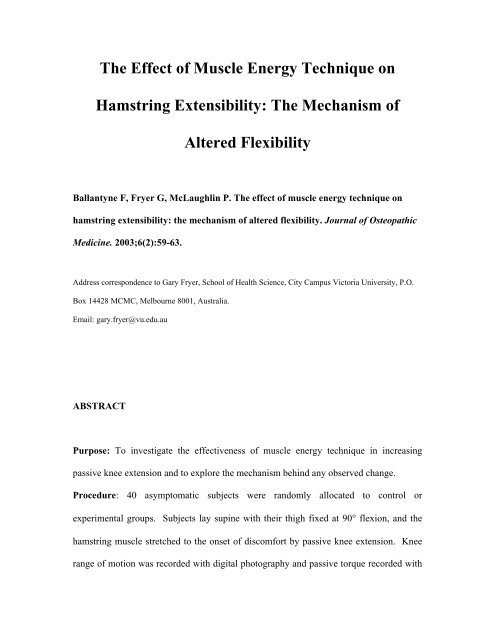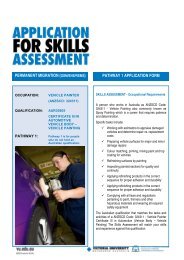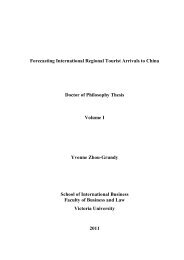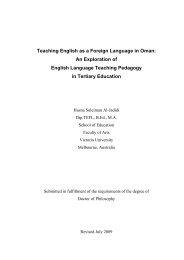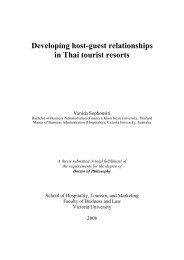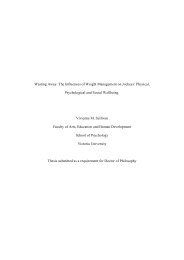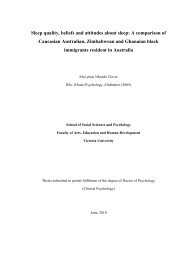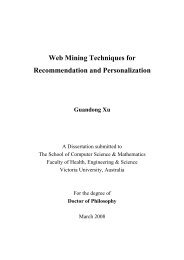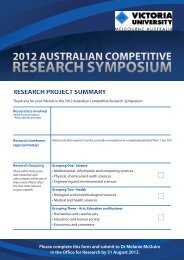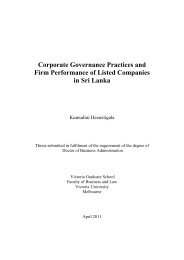THE EFFECT OF MUSCLE ENERGY TECHNIQUE ON HAMSTRING ...
THE EFFECT OF MUSCLE ENERGY TECHNIQUE ON HAMSTRING ...
THE EFFECT OF MUSCLE ENERGY TECHNIQUE ON HAMSTRING ...
- No tags were found...
You also want an ePaper? Increase the reach of your titles
YUMPU automatically turns print PDFs into web optimized ePapers that Google loves.
The Effect of Muscle Energy Technique onHamstring Extensibility: The Mechanism ofAltered FlexibilityBallantyne F, Fryer G, McLaughlin P. The effect of muscle energy technique onhamstring extensibility: the mechanism of altered flexibility. Journal of OsteopathicMedicine. 2003;6(2):59-63.Address correspondence to Gary Fryer, School of Health Science, City Campus Victoria University, P.O.Box 14428 MCMC, Melbourne 8001, Australia.Email: gary.fryer@vu.edu.auABSTRACTPurpose: To investigate the effectiveness of muscle energy technique in increasingpassive knee extension and to explore the mechanism behind any observed change.Procedure: 40 asymptomatic subjects were randomly allocated to control orexperimental groups. Subjects lay supine with their thigh fixed at 90° flexion, and thehamstring muscle stretched to the onset of discomfort by passive knee extension. Kneerange of motion was recorded with digital photography and passive torque recorded with
a hand-held dynamometer. The experimental group received muscle energy technique tothe hamstring muscle, after which the resistance to stretch and the range of motion wereagain measured. The knee was extended to the original passive torque and the angle atthe knee recorded. If the onset of discomfort was not produced at this angle, the kneewas further extended and the new angle was recorded.Results: A significant increase in range of motion was observed at the knee (p< 0.019)following a single application of MET to the experimental group. No change wasobserved in the control group. When an identical torque was applied to the hamstringboth before and after the MET, no significant difference in range of motion of the kneewas found in the experimental group.Conclusions: Muscle energy technique produced an immediate increase in passive kneeextension. This observed change in range of motion is possibly due to an increasedtolerance to stretch as there was no evidence of visco-elastic change.INTRODUCTI<strong>ON</strong>Muscle energy technique (MET) is a manual technique developed by osteopathsthat is now used in many different manual therapy professions. It is claimed to beeffective for a variety of purposes, including lengthening a shortened or contracturedmuscle, strengthening muscles, as a lymphatic or venous pump to aid the drainage offluid or blood, and increasing the range of motion (ROM) of a restricted joint. 1Whilemuscle energy techniques are widely used by osteopaths and other manual therapists,there is limited research supporting and validating its use, as well as limited evidence tosubstantiate the theories used to explain the effects of MET.
Several researchers have examined the effect of contract-relax techniques (similarto MET) on hamstring flexibility, and found that these techniques produced increasedmuscle flexibility. 2, 3, 4,5 Handel et al. 2 identified significant increases in hamstringflexibility along with an increase in passive torque (increase in force used to stretch thehamstring) after a contract-relax exercise program. Wallin et al. 3 claimed that contractrelaxtechniques were more effective than ballistic stretching for improving muscleflexibility over a 30-day period, whereas other researchers, however, have reported nodifferences between the two techniques. 4The mechanical component of muscle flexibility during static stretch is betterunderstood than the mechanisms of therapeutic action of MET. Resting tension inskeletal muscles is taken up mainly by the myofibrils, and as the muscle stretches thelimit to the range of motion is attributed to the visco-elastic elements of the connectivetissues. 6Visco-elasticity refers to the response of a tissue to load, a property of elasticand viscous components. The elastic component is the ability of the tissue to return to itsprevious form after deformation. The viscous component relates to the fluid part of themuscle, which deviates in response to mechanical forces.When visco-elastic structuresare held at constant stretch, the stress or force of the material gradually declines. Tayloret al. have demonstrated visco-elastic change in rabbit foreleg muscles. 7In humanexperiments, visco-elasticity seems harder to demonstrate. While a small number ofstudies have found that visco-elastic stress relaxation is evident in human skeletalmuscle, 5, 8,9 both Magnusson et al. 5,10,11 and Halbertsma et al. 12,13 demonstrated thatincreased muscle extensibility was attributed to use of increased torque. A visco-elasticchange would have been evident if increased muscle length was achieved using a
constant torque (force of stretch). The change in extensibility after stretching can only beattributed to an increase in stretch tolerance (the subject can tolerate more force appliedto the muscle) because increased muscle flexibility resulted only when the torqueincreased.Apart from the flexibility of the myofascial tissue itself, other structures areinvolved in the resistance of a muscle to stretch. When measuring the range of motion ofa joint, the structures surrounding the joint itself – joint capsules, ligaments and physicalstructures of the bone articulation - provide resistance to the overall range of motion of aparticular joint. In addition to this, the skin and subcutaneous connective tissue may alsoplay a large part in the restriction of a joint’s motion. 14, 15 Johns and Wright 16 haveshown that the passive torque that is required to move a joint is contributed by the jointcapsule (47%), tendon (10%), muscle (41%), and skin (2%).Some authors 17have speculated on the neurological mechanisms that mayproduce increased range of motion of a joint after MET, however, there is little researchto substantiate these theories. Kuchera 17attributed the effectiveness of MET to theinhibitory golgi tendon reflex. This reflex is believed to be activated during isometriccontraction of muscles, which is claimed to produce a stretch on the golgi tendon organs14, 18and a reflex relaxation of the muscle. Thistheory, however, is poorly supported byresearch. Taylor et al. 7 showed in rabbit muscles that no difference in response to stretchwas found between innervated and denervated muscles, suggesting that the neuralcomponent to muscle flexibility is negligible. Various studies have shown that passivestretch does not influence the electrical activity of the hamstring muscle (using EMG) 8, 19,
20, 21,demonstrating that low level muscle contraction does not limit muscle flexibility,disputing the proposal of a neurological mechanism.It has been suggested that a viscoelastic change in muscle is responsible for theincrease in muscle flexibility after MET, 22but this theory remains largely untested.Stretching of the connective tissue elements when the muscle isometrically contractsfrom a lengthened position has been offered as another explanation of the observed rangeof motion increase, and explains the greater flexibility achieved with contract-relaxexercises when compared with static stretch. 22 Increased tolerance to stretch, which hasbeen demonstrated following passive static stretching of the hamstring muscles, 11 mayalso play a role in the apparent increased flexibility of muscles following MET. Handel etal. 2suggest that an increased stretch tolerance is a possible mechanism behind theincreased ROM seen in their study after the contract-relax exercise program.Mechanisms underlying improved muscle flexibility following static stretch,contract-relax stretching or MET remains obscure, and may be a result of biomechanicalor neurophysiological changes, or an increase in tolerance to stretching. The presentstudy aimed to determine whether a single application of MET could produce animmediate significant change in the flexibility of the hamstring muscle and whether anysuch increase was due to changes in the mechanical property of the muscle, or a result ofincreased tolerance to stretch. Single applications of MET are often used in osteopathicpractice and it is hoped that this study may clarify the mechanisms behind immediateincreased flexibility.
MATERIALS AND METHODSParticipantsThe Human Research Ethics Committee of Victoria University approved thestudy. Subjects were recruited from students enrolled at Victoria University, Melbournewho volunteered after being informed of the nature and purpose of this study. 40volunteers (22 female, 18 male) aged between 18 and 45 (average age 23.4 years) gavewritten consent prior to participation and were free to withdraw at any time from thestudy. The subjects did not exhibit any lower extremity or low back pathology at the timeof the study.Experimental designThe design was a randomised, controlled and blinded experimental study.Following recording of the initial measurements (ROMpre and torque 1), subjects weremoved to a separate room and randomly assigned to either control (n=20; female=11,male=9) or experimental group (n=20; female=11, male=9) to which the researcherconducting the measurements was blinded. Subjects in the experimental group weretreated with MET, whereas those in the control group lay on the treatment table for thesame amount of time. All subjects then returned to the first room for re-measurement.
Volunteers (N=40)PRE-TESTTester 1Randomised allocationTester 2 MET (N=20) Control (N=20)Tester 1 blinded to allocationPOST-TESTTester 1Figure 1: Study designMeasurement techniquesA Nicholas hand-held dynamometer (Lafyette, USA) (Figure 2) was used toassess resistance to stretch (defined as passive torque (Nm) of hamstring muscles) duringpassive knee extension. During the measurement all subjects were supine with therandomly selected experimental thigh flexed to 90° at the hip. The thigh of the oppositeleg was firmly secured to minimise rotation of the pelvis during measurement (Figure 3).
Measurement of the range of passive knee extension (PKE) was achieved by jointmarking, pre and post-photography of bony landmarks (greater trochanter, lateral femoralcondyle and lateral malleolus), and analysis of digital photos by Swinger 1.29Professional software.Muscle ROM was recorded at three stages:1. ROMpre – pre-test ROM was recorded with the participant reporting the first senseof hamstring “discomfort”. 232. ROMpost1 – post-test ROM was recorded with the same amount of passive torque asused in ROMpre.3. ROMpost2 – post-test ROM was recorded when the hamstring was further extendedto the first sense of hamstring “discomfort”.Measurements of ROMpre and ROMpost2 were completed three times and theaverage recorded. Only one measure of ROMpost1 was conducted to avoid producingfurther visco-elastic change after treatment. Passive torque was recorded in ROMpre andrepeated for ROMpost1 to ensure the same torque (torque 1) was applied. Anotherrecording (torque 2) was made for ROMpost2 if hamstring discomfort was not producedat ROMpost1 and could be extended further.Muscle Energy TechniqueThe muscle energy technique was then applied to the experimental group. Thesubject’s knee was extended to the first report of hamstring discomfort and a moderate
isometric contraction (approx 75% of maximal) of the hamstring muscle was then elicitedfor a period of five seconds. 1 After a period of three seconds relaxation, the techniquewas repeated three times (for a total of four contractions).AnalysisThe raw data was collated using Microsoft Excel. Repeated Measures ANOVAwas used to analyse pre and post test ROM and torque values in both control andexperimental groups. This analysis was performed using SPSS v11 software.RESULTSMean data indicates that there were minimal changes across time for the range ofmotion data (Table 1). However, in both the control and experimental groups, thesedifferences were large enough to produce significant results (Table 2).On further analysis, it would appear that in the control group, the mean score forthe first post-test measurement (165.1°), is different to both the pre (167.8°) and secondpost test (167.9°) scores. This result was not expected.In the experimental group, there is a difference between the second post-testmeasure (170°) and both the other measures. The difference between the pre-test score(167.3°) and the second post-test score indicates an increase in ROM produced by theintervention. However, the variability in the data necessitates caution when interpretingthese results.
There was a significantly greater amount of torque required to produce end rangein the experimental group (p=0.047). This would equate to an increase in ROM.ControlExperimentalROM Torque ROM TorqueMean SD Mean SD Mean SD Mean SD.Pre test 167.8 7.3 14.6 3.3 167.3 7.3 13.7 3.2Post test 1 165.1 8.1 166.6 9.7Post test 2 167.9 7.0 14.6 3.2 170.0 8.0 14.3 3.4Table 1: Descriptive statistics of control and experimental groups. ROM measured indegrees, torque in N.mF pROM (Con) 6.029 0.005ROM (Exp) 4.421 0.019Torque (Con) 0.004 0.948Torque (Exp) 4.534 0.047Table 2: Repeated measures ANOVA summary
10.0Error Bars show Mean +/- 1.0 SDBars show Means7.5pre-post diff5.02.50.00.0 2.7controlexperimentalgroupFigure 4: ROMpost – ROMpre mean differences (degrees)DISCUSSI<strong>ON</strong>This study demonstrated that a significant increase in hamstring extensibility(measured as ROM at the knee following PKE) occurred following MET (when stretchedto the point of discomfort), but did not occur in the control group. The data suggests thatno viscoelastic changes occurred as a result of a single application of MET. If asignificant increase in joint angle was observed at the initial pre-test load (Torque1)following the MET, a change in tissue property could be the only logical explanation. 11This was not the case as no significant change in range of motion at the knee occurred in
the experimental group when the same initial load was applied (ROMpost1 = ROMpre).A greater torque (Torque 2) was tolerated in the experimental group before discomfortoccurred (ROMpost2), supporting the theory that increased flexibility was a result of anincreased tolerance to stretch.A significant decrease in PKE was observed in the control group when the kneewas extended with the original torque. There were four outliers within the control groupthat were not excluded. Measurement error may have occurred as a result of a designflaw in the study. The knee was extended to the torque determined prior to theintervention and the angle recorded (ROMpost1) only once in both groups, so as to notproduce further visco-elastic change and mask a potentially small treatment effect. Theother measurements (ROMpre and ROMpost2) were performed three times and averaged,minimising the influence of individual outliers.In the experimental group, there was no significant change in ROM followingMET at the pre-test torque (Torque 1). If this had occurred, a change in the tissueproperty (visco-elastic change) could be concluded. 11Hamstring stretching at pre-testtorque, however, did not reproduce the sense of discomfort following MET, and could beincreased to a greater torque (Torque 2) and range (ROMpost2). This observationsuggests that the increased PKE (greater ROM at the knee) is a result of an increasedtolerance to stretch in the absence of any viscoelastic change.RecommendationsWhile the concept of visco-elasticity is accepted in relation to muscle physiology,it is likely that a single application of MET is not enough to produce a change in
iomechanical tissue property. This is not surprising in light of the research examiningthe effects of static stretching. 8,9,11 Future studies should explore whether repeated use ofMET over a period of time produces any lasting viscoelastic changes, and the effect ofvarying the duration of isometric contraction. It would also be of interest to observe theeffects of MET in subjects with a history of hamstring injury. It is possible that suchinjuries involve deposition of abnormal fibrous tissue and cross-linkages, 22 and mayrespond differently to healthy muscle. It is also recommended that future studies use theaverage of three measurements for the recording of the joint angle at every stage theangle is measured, to eliminate the influence of individual measurement outliers.C<strong>ON</strong>CLUSI<strong>ON</strong>This study found that a single application of MET produced an increase in passivestretch of the hamstring muscle. When the post-test torque applied to the muscleremained constant (the same as used in pre-testing), no significant change in lengthoccurred. This suggested that a single application of MET produced no biomechanicalchange to the muscle, but created a change in tolerance to stretch.References:1 Greenman P. Principles of Manual Medicine. 2 nd ed. Baltimore: Williams &Wilkins; 1996: 93-982 Handel M, Horstmann T, Dickhuth HH,Gulch RW. Effects of contract-relax stretching training onmuscle performance in athletes. European Journal of Applied Physiology. 1997; 76:400-4083 Wallin D, Ekblom B, Grahn R, Nordenborg T. Improvement in muscle flexibility. A comparisonbetween two techniques. American Journal of Sports Medicine. 1985; 13(4): 263-84 Gribble PA, Guskiewicz KM, Prenctice WE, Shields EW. Effects of static and hold-relax stretching onhamstring range of motion using the FlexAbility LE1000. Journal of Sport Rehabilitation. 1999;8:195-2085 Magnusson SP, Simonsen EB, Aagaard P, Dyhre-Poulsen P, McHugh M, Djaer M. Mechanical andPhysiological Responses to Stretching With and Without Pre-isometricContraction in Human SkeletalMuscle. Archives of Physical Medicine and Rehabilitation. 1996; April 77: 373-86 McHugh MP, Magnusson SP, Gleim GW, Nicholas JA. Viscoelastic stress relaxation in human skeletalmuscle. Medicine and Science in Sports and Exercise. 1992; 24(12): 1375-1382
7 Taylor DC, Dalton JD, Seaber AV, Garret W. Viscoelastic properties of muscle-tendon units: Thebiomechanical effects of stretching. The American Journal of Sports Medicine. 1990; 18(3): 300-3098 Magnusson SP, Simonsen EB, Dyhre-Poulsen P, Aagaard P, Mohr T, Kjaer M. Viscoelastic stressrelaxation during static stretch in human skeletal muscle in the absence of EMG activity. ScandinavianJournal of Medicine and Science in Sports. 1996: 6; 323-3289 Magnusson SP, Simonsen EB, Aagaard P, Gleim GW, McHugh MP, Kjaer M. Viscoelastic response torepeated static stretching in the human hamstring muscle. Scandinavian Journal of Medicine and Science inSports. 1995: 5; 342-34710 Magnusson SP, Aagaard P, Simonsen W, Bojsen-Maller F. A Biomechanical Evaluation of Cyclic andStatic Stretch in Human Skeletal Muscle. International Journal of Sports Medicine 1998; 19: 310-31611 Magnusson SP, Simonsen EB, Aagaard P, Sorensen H, Kjaer M. A mechanism for altered flexibility inhuman skeletal muscle. Journal of Physiology. 1996; 497.1: 291-29812 Halbertsma JP, Mulder I, Goeken LN, Eisma WH. Repeated Passive Stretching: Acute Effect on thePassive Muscle Moment and Extensibility of Short Hamstrings. Archives of Physical Medicine andRehabilitation. 1999; April 80: 407-41313 Halbertsma JP, Van Bolhuis AI, Goeken LN. Sport Stretching: Effect on Passive MuscleStiffness onShort Hamstrings. Archives of Physical Medicine and Rehabilitation. 1996; July 77: 688-69214 Shellock FG, Prentice WE. Warming-Up and Stretching for Improved Physical Performance andPrevention of Sports-Related Injuries.Sports Medicine. 1985: 2(4); 267-27815 Gajdosik RL. Effects of Static Stretching on the Maximal Length and Resistance to Passive Stretch ofShort Hamstring Muscles. Journal of Sports Physical Therapy. 1991; 14(6): 250-25516 Johns RJ, Wright V. Relative importance of various tissues in joint stiffness. Journal of AppliedPhysiology. 1962; 17: 824-82817 Kuchera WA, Kuchera ML. Osteopathic Principles in Practice. 2 nd ed revised. Kirksville, Missouri:KCOM Press; 199218 Hutton RS. Neuromuscular Basis of Stretching Exercises. In:Komi PV. Strength and Power in Sport.UK:Blackwell Sciences Ltd; 1992; 29-3819 Klinge D, Magnusson SP, Simonsen EB, Aagaard P, Klausen K, Kjaer M. The effect of strength andflexibility training on skeletal muscle electromyographic activity, stiffness, and viscoelastic stressrelaxation response. The American Journal of Sports Medicine. 1997; 25(5): 710-71620 McHugh MP, Kremenic IJ, Fox MB, Gleim GW. The role of mechanical and neural restraints to jointrange of motion during passive stretch. Medicine and Science in Sports and Exercise. 1998; 30(6): 928-93221 Osternig LR, Robertson RN, Troxel RK, Hansen P. Differential responses to proprioceptiveneuromuscular facilitation (PNF) stretch techniques. Medicine and Science in Sports and Exercise. 1990;22(1): 106-11122 Lederman E, Fundamentals of Manual Medicine. UK: Churchill Livingstone: 199723 Magnusson SP, Aagaard P, Nielson JJ. Passive Energy Return After Repeated Stretches of the HamstringMuscle-tendon Unit. Medicine and Science in Sports and Exercise. 2000; 32(6): 1160-1164


